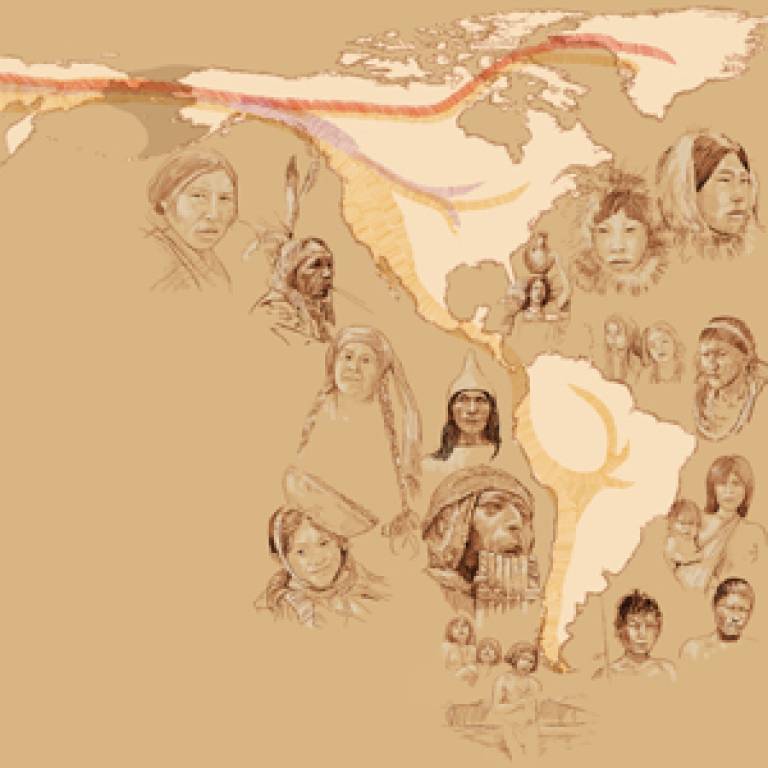Native American populations descend from three key migrations
12 July 2012
Scientists have found that Native American populations - from Canada to the southern tip of Chile - arose from at least three migrations, with the majority descended entirely from a single group of First American migrants, more than 15,000 years ago.

This single group of First American migrants crossed over through Beringia, a land bridge between Asia and America that existed during the ice ages.
By studying variations in Native American DNA sequences, the international team found that while most of the Native American populations arose from the first migration, two subsequent migrations also made important genetic contributions. The paper is published in the journal Nature today.
"For years it has been contentious whether the settlement of the Americas occurred by means of a single or multiple migrations from Siberia," said Professor Andres Ruiz-Linares (UCL Genetics, Evolution and Environment), who coordinated the study. "But our research settles this debate: Native Americans do not stem from a single migration. Our study also begins to cast light on patterns of human dispersal within the Americas."
In the most comprehensive survey of genetic diversity in Native Americans so far, the team took data from 52 Native American and 17 Siberian groups, studying more than 300,000 specific DNA sequence variations called Single Nucleotide Polymorphisms to examine patterns of genetic similarities and differences between the population groups.
The study of Native American populations is technically very challenging because of the widespread occurrence of European and African mixture in Native American groups
Professor Andres Ruiz-Linares
The second and third migrations have left an impact only in Arctic populations that speak Eskimo-Aleut languages and in the Canadian Chipewyan who speak a Na-Dene language. However, even these populations have inherited most of their genome from the First American migration. Eskimo-Aleut speakers derive more than 50% of their DNA from First Americans, and the Chipewyan around 90%. This reflects the fact that these two later streams of Asian migration mixed with the First Americans they encountered after they arrived in North America.
"There are at least three deep lineages in Native American populations," said co-author David Reich, Professor of genetics at Harvard Medical School. "The Asian lineage leading to First Americans is the most anciently diverged, whereas the Asian lineages that contributed some of the DNA to Eskimo-Aleut speakers and the Na-Dene-speaking Chipewyan from Canada are more closely related to present-day East Asian populations."
The team also found that once in the Americas, people expanded southward along a route that hugged the coast with populations splitting off along the way. After divergence, there was little gene flow among Native American groups, especially in South America.
Two striking exceptions to this simple dispersal were also discovered. First, Central American Chibchan-speakers have ancestry from both North and South America, reflecting back-migration from South Americaand mixture of two widely separated strands of Native ancestry. Second, the Naukan and coastal Chukchi from north-eastern Siberia carry 'First American' DNA. Thus, Eskimo-Aleut speakers migrated back to Asia, bringing Native American genes.
The team's analysis was complicated by the influx into the hemisphere of European and African immigrants since 1492 and the 500 years of genetic mixing that followed. To address this, the authors developed methods that allowed them to focus on the sections of peoples' genomes that were of entirely Native American origin.
"The study of Native American populations is technically very challenging because of the widespread occurrence of European and African mixture in Native American groups," said Professor Ruiz-Linares.
"We developed a method to peel back this mixture to learn about the relationships among Native Americans before Europeans and Africans arrived," Professor Reich said, "allowing us to study the history of many more Native American populations than we could have done otherwise."
The assembly of DNA samples from such a diverse range of populations was only possible through a collaboration of an international team of 64 researchers from the Americas (Argentina, Bolivia, Brazil, Canada, Chile, Colombia, Costa Rica, Guatemala, Mexico, Peru, Russia and the USA), Europe (England, France, Spain and Switzerland) and Russia.
Links:
Professor Andres Ruiz-Linares
UCL Research Department of Genetics, Evolution and Environment
Professor David Reich
 Close
Close

